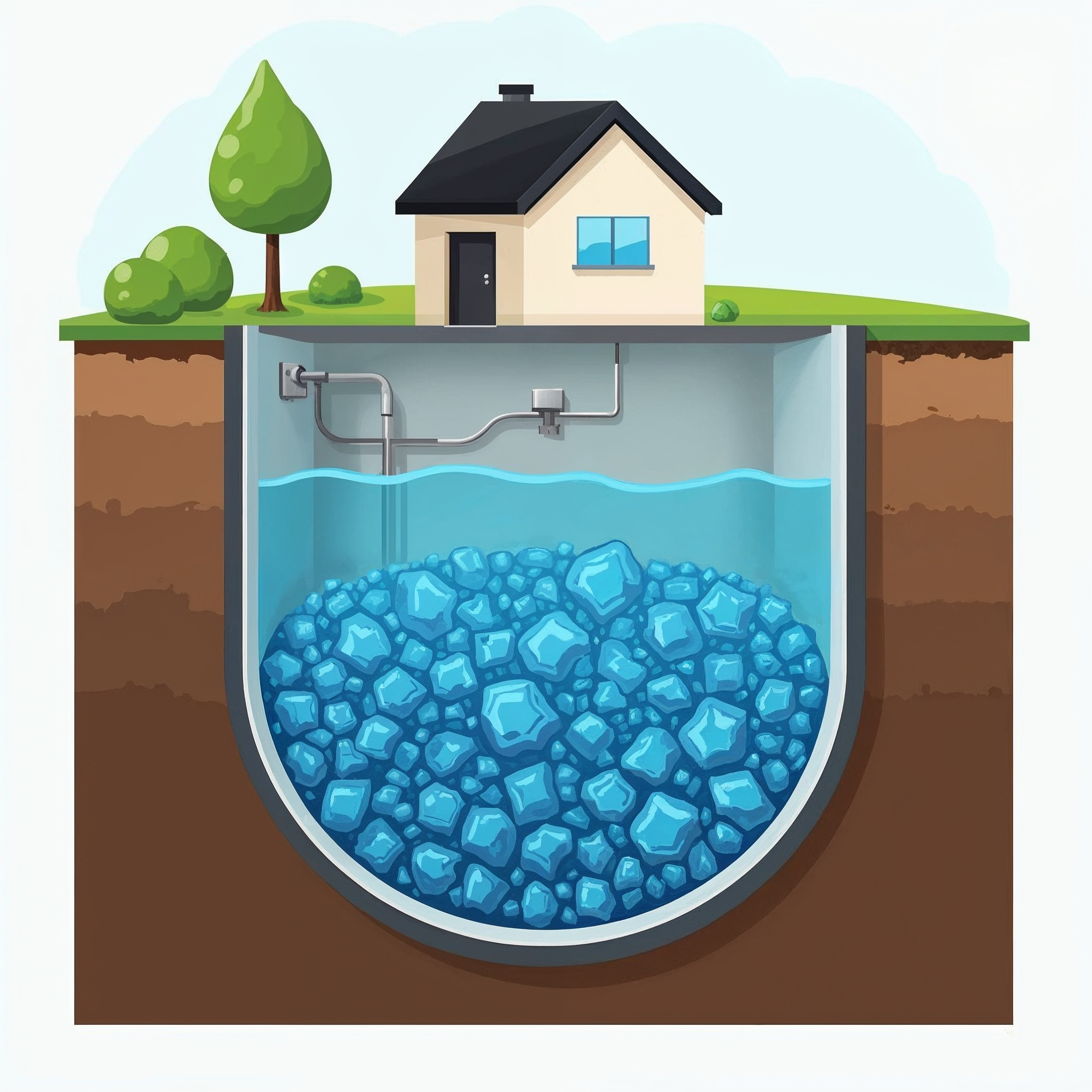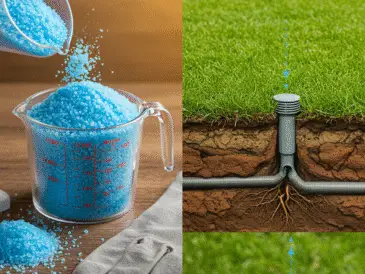How Much Copper Sulfate for Septic Tank: A Complete Guide to Safe and Effective Treatment
Is your septic tank in need of a little TLC? Copper sulfate might be the solution, but the right amount is crucial for both effectiveness and safety. Using too little could leave your system vulnerable to clogs and odors, while too much can disrupt the delicate balance of beneficial bacteria that keep your tank functioning properly. In this comprehensive guide, we will delve into how much copper sulfate you should use for your septic tank, exploring not only the ideal dosage but also the benefits and potential risks involved. Whether you’re a seasoned homeowner or new to septic tank maintenance, understanding the proper use of copper sulfate is key to ensuring your system operates smoothly. Get ready to discover expert tips and practical advice that will help you maintain a healthy septic system while navigating the complexities of this essential chemical. Let’s dive in!
Understanding Copper Sulfate and Its Role in Septic Systems
Copper sulfate, chemically known as CuSO₄, is a crystalline compound that has been used for decades in various applications, including septic tank maintenance. When it comes to septic systems, copper sulfate serves multiple purposes, primarily as a root killer and bacterial regulator. This blue crystalline substance works by creating an environment that discourages root intrusion while helping to control certain types of harmful bacteria that can interfere with the natural decomposition processes in your septic tank.
The science behind copper sulfate’s effectiveness lies in its antimicrobial properties. When dissolved in water, it releases copper ions that can eliminate specific microorganisms while, when used correctly, preserving the beneficial bacteria essential for breaking down waste. This delicate balance is what makes proper dosing so critical. Too much copper sulfate can create a sterile environment that disrupts the entire septic ecosystem, while too little may not provide the intended benefits.
Understanding your septic system’s basic operation is crucial before introducing any chemical treatments. A typical septic system consists of a septic tank where solids settle and undergo bacterial decomposition, and a drain field where liquid effluent is filtered through soil. The tank relies on anaerobic bacteria to break down organic matter, producing gases and liquid waste. This natural process can be enhanced or hindered depending on what chemicals are introduced to the system.
Determining the Correct Dosage: Size Matters
The amount of copper sulfate needed for your septic tank depends primarily on the tank’s capacity and the specific issues you’re addressing. For standard residential septic tanks, which typically range from 750 to 1,500 gallons, the general recommendation is to use between 2 to 8 pounds of copper sulfate annually. However, this broad range requires further refinement based on your specific circumstances.
For a 1,000-gallon septic tank, which is common in many residential settings, the recommended starting dose is approximately 2 pounds of copper sulfate crystals. This should be divided into smaller applications rather than added all at once. The preferred method is to add half a pound every three months, ensuring gradual introduction that won’t shock the system’s bacterial balance.
Larger tanks require proportionally more copper sulfate. A 1,500-gallon tank might need up to 3 pounds annually, while smaller 750-gallon systems should use no more than 1.5 pounds per year. These calculations assume normal usage patterns and average waste loads. Households with higher-than-average water usage or those dealing with specific root intrusion problems may require slight adjustments to these baseline recommendations.
The timing of applications is equally important as the quantity. Rather than adding the full annual amount at once, distribute the copper sulfate across multiple applications throughout the year. This approach maintains consistent levels in the tank while minimizing the risk of bacterial die-off that can occur with large, sudden chemical introductions.
Step-by-Step Application Process
Proper application of copper sulfate requires careful preparation and timing. Begin by calculating your septic tank’s approximate capacity if you don’t already know it. Most residential tanks have their capacity marked on the access lid or in the home’s septic system documentation. If this information isn’t available, a septic professional can help determine the tank size during routine maintenance.
Start the application process by flushing the copper sulfate crystals down your main bathroom toilet late in the evening when household water usage is minimal. This timing ensures the crystals have maximum contact time with the tank contents before being diluted by additional water flow. Use the toilet closest to your septic tank, typically the main bathroom, as this provides the most direct path to the tank.
Pour the measured amount of copper sulfate crystals directly into the toilet bowl, then flush immediately. The crystals will dissolve as they travel through the plumbing system and settle in the septic tank. Avoid using other plumbing fixtures for at least 8 hours after application to allow the copper sulfate to work effectively before being diluted.
For households with water softener systems, coordinate copper sulfate applications with the softener’s regeneration cycle. Apply the copper sulfate at least 24 hours before the water softener regenerates to prevent the high salt concentrations from interfering with the copper sulfate’s effectiveness.
Monitor your septic system’s performance in the weeks following application. Signs of proper dosing include reduced odors, fewer drain backups, and normal waste processing. If you notice increased odors or slower drainage, you may have used too much copper sulfate, and you should reduce the next application accordingly.
Root Control: Primary Use of Copper Sulfate
One of the most common reasons homeowners turn to copper sulfate is for root control in septic systems. Tree and shrub roots naturally seek out moisture and nutrients, making septic tanks attractive targets. These roots can infiltrate through small cracks or joint separations in older concrete or clay pipes, eventually forming dense mats that block normal flow and can cause expensive damage.
Copper sulfate works as a root killer by creating a toxic environment for plant tissue upon contact. When roots encounter copper sulfate-treated water, the copper ions interfere with the plants’ cellular processes, causing root death and preventing further growth into the septic system. This process typically takes several weeks to show full effectiveness, so patience is essential when using copper sulfate for root control.
For active root intrusion problems, slightly higher concentrations may be necessary initially. In cases of severe root infiltration, use up to 1 pound of copper sulfate per 300 gallons of tank capacity, but only as a one-time treatment. Follow this initial treatment with regular maintenance doses to prevent future root problems. This higher concentration should only be used under professional guidance, as it significantly increases the risk of beneficial bacteria loss.
Prevention is always better than treatment when it comes to root intrusion. Regular copper sulfate maintenance applications, combined with proper landscaping practices, can prevent most root problems. Keep large trees and shrubs at least 10 feet away from septic system components, and consider installing root barriers in areas where vegetation proximity cannot be avoided.
The effectiveness of copper sulfate for root control varies depending on plant species, soil conditions, and the severity of existing intrusion. Some aggressive root systems may require multiple treatments or alternative control methods. Professional assessment may be necessary for persistent root problems that don’t respond to standard copper sulfate treatments.
Bacterial Balance and Ecosystem Health
The most critical aspect of using copper sulfate in septic systems is maintaining the delicate bacterial ecosystem that makes waste decomposition possible. Septic tanks rely on complex communities of anaerobic bacteria to break down organic matter, and these microorganisms are sensitive to chemical disruptions. Understanding this balance is essential for successful copper sulfate use.
Beneficial bacteria in septic systems include cellulolytic bacteria that break down paper and plant matter, proteolytic bacteria that decompose proteins, and methanogenic archaea that produce methane gas. These organisms work together in a carefully balanced ecosystem that can take months to fully establish and can be disrupted by sudden chemical changes.
Copper sulfate, when used in appropriate concentrations, primarily targets harmful bacteria and plant roots while having minimal impact on the beneficial anaerobic bacteria essential for waste processing. However, exceeding recommended dosages can create a broad-spectrum antimicrobial effect that kills both harmful and beneficial microorganisms, leading to system failure.
Signs of bacterial imbalance include increased odors, slower waste decomposition, accumulation of scum layers, and frequent need for pumping. If these symptoms appear after copper sulfate application, discontinue use and consider adding bacterial supplements specifically designed for septic systems to help restore the microbial balance.
To protect bacterial health while using copper sulfate, never exceed recommended dosages, space applications at least three months apart, and avoid simultaneous use of other antimicrobial products like bleach-based cleaners or antibacterial soaps. Consider using septic-safe bacterial additives between copper sulfate treatments to maintain robust microbial populations.
Safety Considerations and Environmental Impact
Copper sulfate handling requires attention to safety protocols due to its chemical properties. The compound can cause skin and eye irritation upon direct contact and can be harmful if ingested. Always wear protective gloves and eyewear when handling copper sulfate crystals, and store the product in a cool, dry location away from children and pets.
When copper sulfate dissolves in septic systems, it eventually reaches groundwater through the drain field. While properly dosed applications typically don’t create environmental problems, excessive use can lead to copper accumulation in soil and groundwater. This accumulation can harm beneficial soil organisms and potentially affect local water quality.
Environmental considerations extend beyond immediate groundwater concerns. Copper is a heavy metal that doesn’t break down naturally, so it can accumulate in soil over time with repeated applications. This accumulation can affect plant growth in the drain field area and may impact the long-term effectiveness of the soil filtration system.
To minimize environmental impact, strictly adhere to recommended dosage guidelines, never exceed annual application limits, and consider alternative root control methods for severely affected systems. Professional soil testing can help monitor copper levels in areas where repeated applications have been necessary.
Local regulations may restrict or prohibit copper sulfate use in septic systems, particularly in areas with sensitive groundwater or near water supplies. Check with local health departments or environmental agencies before beginning any copper sulfate treatment program to ensure compliance with applicable regulations.
Alternative Approaches and When to Avoid Copper Sulfate
While copper sulfate can be effective for septic tank maintenance, it’s not appropriate for all situations. New septic systems, those with recently established bacterial populations, and systems experiencing active bacterial issues should avoid copper sulfate until biological balance is restored. Additionally, systems with known copper sensitivity or those in environmentally sensitive areas may require alternative approaches.
Mechanical root removal offers a chemical-free alternative for severe root intrusion problems. Professional septic services can use specialized equipment to cut and remove roots from pipes and tanks, though this approach addresses symptoms rather than preventing future growth. Regular professional cleaning combined with proper landscaping practices can often eliminate the need for chemical root control.
Biological additives present another alternative, using specific bacterial strains and enzymes to enhance natural waste decomposition processes. These products can improve system performance without the environmental concerns associated with copper sulfate. However, their effectiveness varies, and they typically cost more than copper sulfate treatments.
Physical barriers, such as copper mesh screens or root-impermeable liners, can prevent root intrusion without introducing chemicals to the septic system. These solutions require professional installation but provide long-term protection without ongoing chemical applications.
For households committed to chemical-free septic maintenance, focus on water conservation, proper waste disposal practices, and regular professional pumping and inspection. These approaches, while requiring more attention to daily habits, can maintain system health without chemical interventions.
Professional vs. DIY Application
Deciding between professional and DIY copper sulfate application depends on several factors including system complexity, local regulations, and personal comfort with chemical handling. Professional application ensures proper dosing, appropriate timing, and compliance with local requirements, but comes with higher costs.
Professional septic services bring expertise in calculating precise dosages based on tank size, waste load, and specific system characteristics. They can also identify underlying problems that chemical treatment won’t solve, such as structural damage or improper system design. Many professionals include copper sulfate treatment as part of comprehensive maintenance programs that address multiple system needs.
DIY application can be cost-effective for homeowners comfortable with following detailed instructions and safety protocols. Success requires accurate tank size determination, careful measurement of copper sulfate quantities, and strict adherence to timing and safety guidelines. DIY approaches work best for routine maintenance rather than addressing active problems.
Consider professional application for initial treatments, systems with a history of problems, or when local regulations require professional oversight. DIY maintenance can then continue with established dosing schedules and proven effectiveness. This hybrid approach balances cost considerations with professional expertise where it’s most valuable.
Regardless of who performs the application, maintain detailed records of dates, quantities used, and system performance. This documentation helps optimize future treatments and provides valuable information for septic professionals during routine inspections or emergency calls.
Monitoring and Maintenance Schedule
Establishing a regular monitoring and maintenance schedule maximizes copper sulfate effectiveness while minimizing risks to system health. Effective monitoring includes both routine observations and periodic professional assessments to ensure optimal system performance.
Create a monthly inspection routine that includes checking for surface odors, unusual wet spots in the drain field area, and any changes in household drainage patterns. Document these observations to identify trends that might indicate developing problems. Early detection allows for corrective action before minor issues become major system failures.
Schedule professional inspections every three years, or more frequently if your system has a history of problems. Professional inspections can identify root intrusion, structural issues, and bacterial imbalances that aren’t apparent through routine homeowner monitoring. These inspections often reveal whether copper sulfate treatments are achieving desired results.
Coordinate copper sulfate applications with other septic maintenance activities. Plan applications for periods when household water usage is minimal, typically during cooler months when outdoor water use decreases. Avoid applications immediately before or after septic pumping to prevent interference with bacterial reestablishment.
Track system performance metrics including pumping frequency, drain field effectiveness, and any recurring problems. Systems requiring more frequent pumping or experiencing repeated backups may need dosage adjustments or alternative treatment approaches. This data helps optimize treatment schedules and identify when professional intervention is necessary.
Cost Analysis and Long-Term Considerations
Understanding the economics of copper sulfate treatment helps homeowners make informed decisions about septic system maintenance. While copper sulfate itself is relatively inexpensive, the total cost of treatment includes safety equipment, proper disposal of containers, and potential professional consultation.
Annual copper sulfate costs typically range from $20 to $60 for residential systems, depending on tank size and application frequency. This cost compares favorably to mechanical root removal, which can cost several hundred dollars per treatment, or system replacement, which can exceed $10,000. However, copper sulfate treatment must be weighed against potential long-term environmental costs and regulatory restrictions.
Factor in the cost of bacterial supplements that may be necessary to maintain system health alongside copper sulfate treatment. These products typically cost $30 to $50 annually but can prevent expensive system failures caused by bacterial imbalances. Consider this additional cost when evaluating the total expense of copper sulfate-based maintenance programs.
Long-term considerations include potential soil copper accumulation, changing environmental regulations, and the cumulative impact on beneficial soil organisms. Some areas are implementing stricter controls on copper sulfate use, which could affect future treatment options. Stay informed about regulatory changes that might impact long-term maintenance strategies.
Compare copper sulfate treatment costs to preventive measures like strategic landscaping and root barriers. While these alternatives have higher upfront costs, they may provide better long-term value in areas with aggressive root problems or environmental sensitivity concerns.
Conclusion: Making Informed Decisions for Your Septic System
Copper sulfate can be an effective tool for septic system maintenance when used properly, but success depends on understanding correct dosages, application methods, and system-specific considerations. The key to effective treatment lies in balancing root control benefits with bacterial ecosystem preservation, always erring on the side of caution when determining appropriate amounts.
Remember that septic systems are complex biological and mechanical systems that benefit from comprehensive maintenance approaches. Copper sulfate treatment should complement, not replace, good household practices, regular pumping, and professional inspections. The most successful septic maintenance programs combine multiple strategies tailored to specific system needs and environmental conditions.
Before beginning any copper sulfate treatment program, assess your system’s specific needs, local regulatory requirements, and long-term maintenance goals. Consider consulting with septic professionals to develop a comprehensive maintenance strategy that addresses root control, bacterial health, and environmental stewardship. This investment in proper planning can prevent expensive problems and ensure reliable system performance for years to come.
The decision to use copper sulfate should be based on specific system needs rather than routine application. Systems without root problems or bacterial imbalances may not benefit from copper sulfate treatment, and unnecessary chemical additions can create problems rather than solve them. Focus on identifying actual issues before implementing chemical solutions.
Ultimately, successful septic system maintenance requires ongoing attention, appropriate chemical use when necessary, and recognition that professional expertise can prevent expensive mistakes. By following proper dosage guidelines, monitoring system performance, and maintaining detailed records, homeowners can effectively use copper sulfate as part of comprehensive septic system care while protecting both their investment and the environment.





